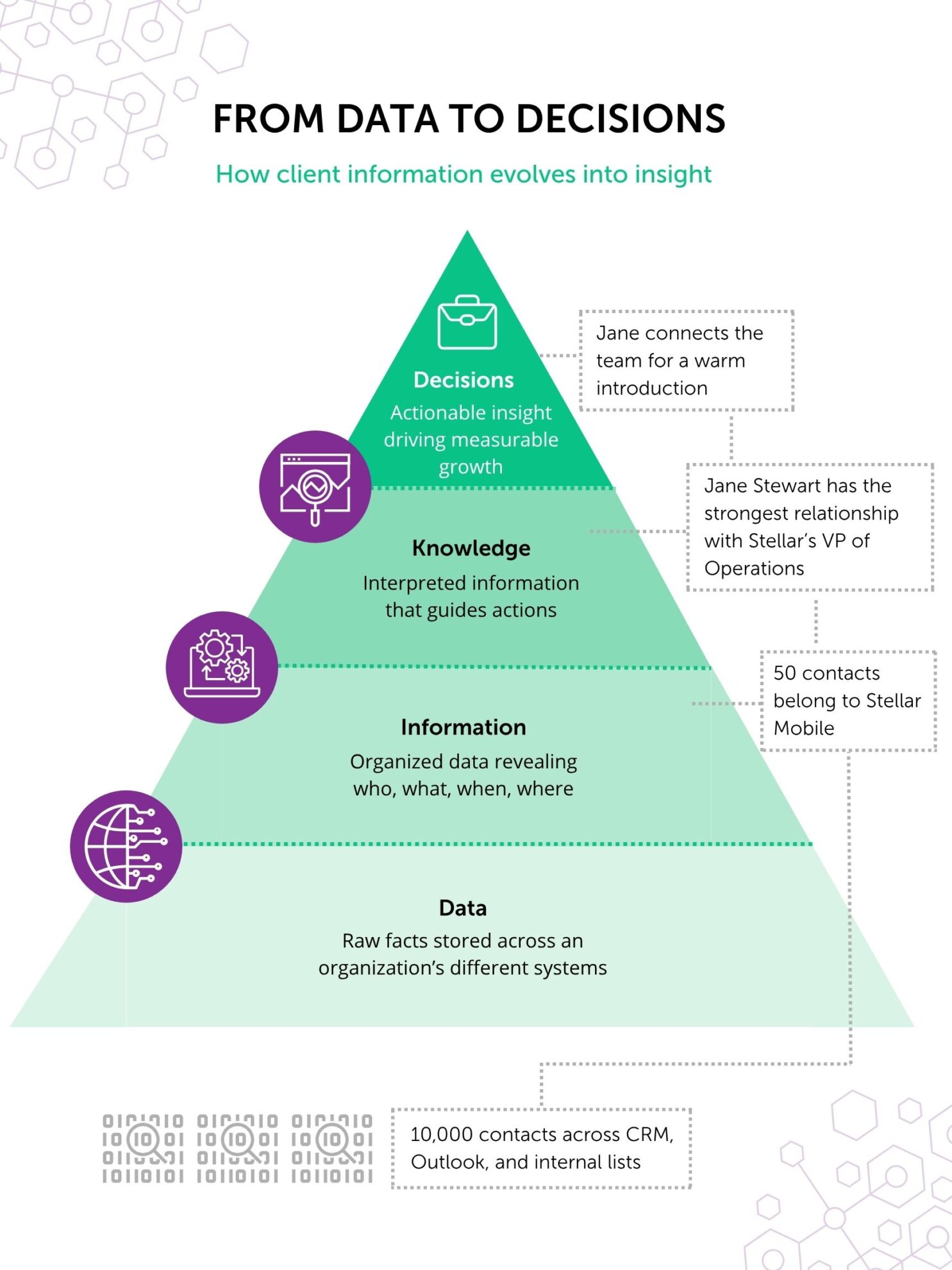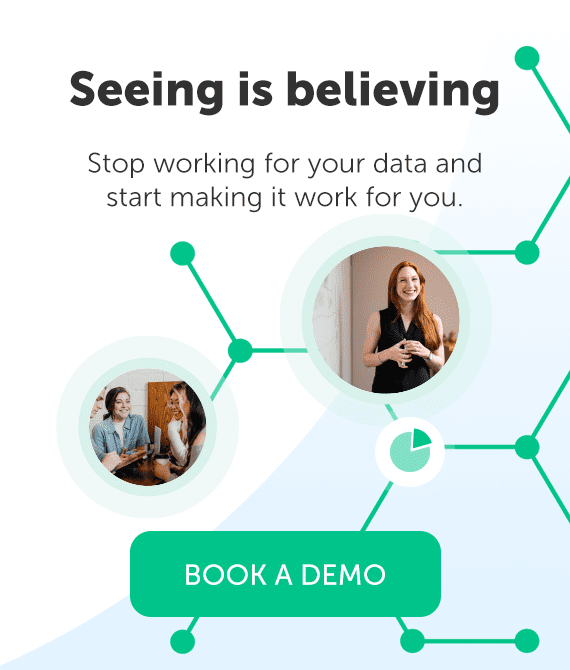The foundation: what is data?
Across systems and teams, data keeps accumulating faster than it can be connected or understood: from CRM records and calendar invites to emails, meeting notes, and client touchpoints. Most of it sits isolated across systems, disconnected from the context that gives it meaning. At this stage, it’s just that: data. For example, a raw list of contacts. Understanding how data, knowledge, and information connect is the first step toward turning those disconnected facts into something useful.
Imagine your employees’ Outlook folders, CRM entries, and marketing lists collectively holding 10,000 names, companies, and email addresses. On the surface, it looks like a valuable asset. But without structure, consistency, or ties to your business objectives such as identifying key accounts or mapping existing relationships, it can’t inform decisions. It’s a clear example of data vs. information: a list of contacts tells you who exists, but not what matters.
This is the base of the growth pyramid: recognizing that data alone doesn’t create value. Organizations often focus on collecting more, not connecting what they already have. But until it’s organized and contextualized, data can’t power client engagement or revenue growth strategies.
Real transformation begins when you begin asking, what does this data mean for our goals? That’s the first move from raw inputs to valuable information and the first real step toward turning data into new pursuits, expanded client relationships, and measurable growth.
Adding context: what is information?
Data becomes information only when it’s organized enough to answer specific questions. Structure and context transform raw inputs into something that reveals who, what, when, and where type answers that data alone simply can’t provide and as EY points out, when business data is given context and connected across functions, it becomes a true knowledge asset. This shift in data vs. information marks the first real turning point in how organizations move up the data–information–knowledge spectrum.
Let’s return to your list of 10,000 disconnected contacts. On its own, that dataset is overwhelming. But when it’s automatically captured, updated, and cleansed in your CRM, it becomes information you can leverage. Now you can see that fifty of those contacts belong to Stellar Mobile, including three executives who’ve previously met with your team. Suddenly, the noise starts to make sense. The resulting information allows you to understand what it actually represents.
This stage of the growth pyramid is where most teams first feel the lift. Information gives you visibility: it helps you see where relationships exist, how active they are, and where engagement might be missing. For example, you might notice that while your firm has 50 contacts at the client Stellar Mobile, there hasn’t been a meaningful interaction with their key stakeholder in the last four months, or that three of your strongest contacts recently changed roles. Those insights help you focus outreach, protect key relationships, and ensure your business development and marketing teams’ effort aligns with real opportunities.
Information is the operational bridge between data and knowledge as the point where your systems start to reflect real activity instead of static records. At this stage, insight replaces inventory: you’re no longer just storing facts but seeing how people, clients, and opportunities connect.
Creating insight: what is knowledge?
If information tells you what’s happening, knowledge explains how and why. It’s the point in the data–information–knowledge–wisdom journey where analysis and experience come together to guide action. In simple terms, knowledge is information interpreted through context in the “so what” that turns visibility into strategy.
Let’s go back to your 50 contacts at Stellar Mobile. Now that your CRM shows who they are and how they connect, you can go deeper. By bringing together email and meeting data, relationship intelligence can surface that your Partner, Jane, has had the most recent engagement with Sarah, the prospect’s VP of Operations and has the strongest relationship with Sarah than anyone else in the organization. That’s not just information; it’s knowledge because it reveals your firm’s position within the account and how to leverage relationships to open the right doors.
Knowledge is where data management becomes more about understanding the contacts in your database. It’s the layer that helps client-facing and business development teams move from observing patterns to acting on them. For example, deciding who should reach out, when, and with what message, as well as ensuring that clients don’t receive conflicting or duplicated communications from different departments of the organization. It’s also where intuition meets intelligence: leaders use these insights to align teams, focus effort where relationships already exist, and turn connections into measurable outcomes.
This stage of the growth pyramid is where the real shift happens. You’re no longer managing data; you’re managing relationships and opportunities. In the data–information–knowledge–wisdom framework, this is the point where technology empowers your professionals to make smarter, faster, more informed decisions. It’s also where the entire data information knowledge wisdom cycle becomes tangible by turning analysis into strategy and relationships into measurable business value.
The DIKW pyramid in action: a visual guide

How technology automates the journey from data to knowledge
Converting disconnected data into meaningful insight is too complex and time-consuming to do manually. Every day, teams across your organization generate thousands of data points: emails, meetings, CRM updates, contact changes. Without automation, most of that information stays buried, disconnected from the client work and business development activities that drive growth.
A relationship intelligence platform like Introhive automates that process. It captures raw data, structures it into useful information, and surfaces the knowledge hidden inside like which clients are most engaged, who in your firm has the strongest connections, and where warm introductions already exist, bridging the data vs. information gap automatically so insights appear without manual effort.
This is what modern relationship management looks like: technology doing the heavy lifting so your people can focus on building relationships, not maintaining databases. Instead of tracking down missing contacts or manually updating CRMs, your team gets a current, connected view of every account and relationship.
In the data–information–knowledge–wisdom framework, automation closes the loop. It turns everyday interactions into actionable insight, helping you uncover opportunities faster, strengthen client relationships, and turn relationship data into measurable business growth as an outcome of the data–information–knowledge–wisdom framework in action.
Ready to see how automation turns your relationship data into growth? Book a demo to see how Introhive helps teams uncover insights, strengthen client connections, and win more business.





